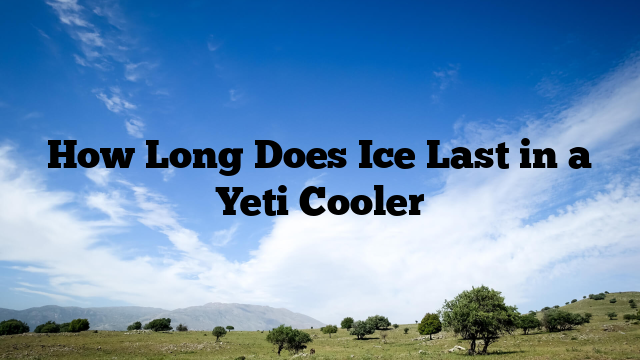Yeti coolers have gained immense popularity and recognition for their durability and ice retention capabilities. Outdoor enthusiasts, campers, fishermen, and even regular individuals looking to keep their drinks and food cold, have all turned to Yeti coolers for their reliable performance.
When it comes to ice retention, the duration that ice lasts in a Yeti cooler can vary depending on several factors. These factors include the size of the cooler, the amount and ratio of ice to food and drinks, the temperature and external conditions, and the pre-cooling of the cooler itself.
In general, a Yeti cooler can hold ice for approximately 3-5 days with regular use, meaning the cooler is half-filled with food, drinks, and other items. This timeframe can vary depending on the ambient temperature and how often the cooler is opened.
When a Yeti cooler is full of ice and kept in ideal conditions, such as being stored in a cool, shaded area, the ice can last for 7-10 days. This duration can be extended by implementing techniques like pre-cooling the cooler and reducing air space by using ice blocks or frozen bottles.
Smaller Yeti Roadie coolers have slightly reduced ice retention times compared to larger models. On average, they can hold ice for 2-4 days, depending on the same factors mentioned above.
On the other hand, larger Yeti 160 coolers can offer impressive ice retention times of over 2 weeks when properly packed and kept in optimal conditions. These coolers are ideal for extended camping trips or situations where access to ice replenishment might be limited.
It’s important to note that these estimates are general guidelines based on average conditions and usage. Various factors can affect ice retention, including the type and size of ice used, insulation materials, and sealing effectiveness of the cooler.
To maximize ice retention in a Yeti cooler, here are some tips:
1. Pre-cool the cooler: Before adding ice, store the empty cooler overnight in a cool place, or even chill it with ice packs or frozen water bottles. This helps to maintain a lower temperature when ice is added.
2. Use larger ice blocks: Instead of regular ice cubes, use larger ice blocks or frozen water bottles. These melt slower and provide better insulation.
3. Fill the cooler to capacity: Reduce the air space in the cooler by filling it as much as possible with food, drinks, and ice. A fully packed cooler retains cold better than one with empty space.
4. Minimize opening the cooler: Limit opening the cooler as much as possible to prevent warm air from entering and cold air from escaping. Consider using a separate cooler for frequently accessed items.
5. Keep the cooler in a shaded area: Avoid direct sunlight and try to keep the cooler in a cool and shaded spot. The external temperature plays a significant role in ice retention.
6. Consider using cooler accessories: Yeti offers various accessories like ice packs, dividers, and baskets that can help organize the cooler and improve ice retention.
7. Keep the cooler closed properly: Ensure that the cooler is sealed tightly to prevent warm air from entering. Yeti coolers are designed with durable rubber gaskets that create an airtight seal.
In addition to these tips, using high-quality ice packs or dry ice can further extend ice retention. Yeti also offers their own ice pack called Yeti Ice, which is specifically designed for their coolers. Yeti Ice can be used in conjunction with regular ice to enhance and prolong cooling capabilities.
It’s worth mentioning that the performance of a Yeti cooler can vary based on external conditions and individual usage. Warmer temperatures, frequent opening and closing of the cooler, and the ratio of ice to items stored can all impact ice retention. However, when compared to regular coolers, Yeti coolers consistently outperform in terms of ice retention due to their superior insulation and construction.
In terms of cleaning, Yeti coolers are easy to maintain. They are made of durable materials that are resistant to stains and odors. Regular cleaning with mild soap and warm water is usually sufficient. Avoid using abrasive cleaners or sharp objects that can damage the cooler’s interior or exterior.
The cost of a Yeti cooler varies depending on the model and size. Yeti coolers are generally considered to be on the higher end of the price spectrum due to their quality and performance. However, many users find the investment worthwhile for the reliability, durability, and extended ice retention that Yeti coolers provide.
While Yeti coolers are widely recognized as top performers in the market, there are alternative coolers available at different price points. Some popular alternatives include RTIC coolers, Pelican coolers, and Engel coolers. These brands offer similar features and ice retention capabilities at a potentially lower cost. However, it’s important to research and compare each brand’s specific models and customer reviews before making a purchasing decision.
In conclusion, Yeti coolers are known for their exceptional ice retention capabilities. With proper usage and following some tips and tricks, a Yeti cooler can hold ice for several days to even weeks, depending on the model and size. By pre-cooling the cooler, using larger ice blocks, packing it tightly with food and drinks, and minimizing exposure to heat and sunlight, users can maximize ice retention. Yeti coolers may come at a higher price point, but many enthusiasts find the investment worthwhile for the consistent performance and long-lasting ice retention they offer.
